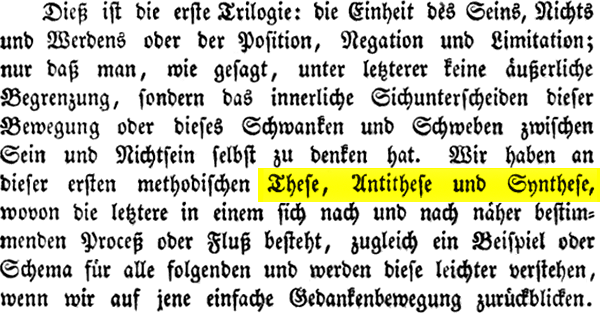..........https://www.jstor.org/stable/2708045
Mueller traces TAS back to a book by the young Karl Marx: The Poverty of Philosophy (1847), and says, further, that Marx most likely got it from a philosophy professor named Heinrich Moritz Chalybäus, who wrote a book called Historical Development of Speculative Philosophy from Kant to Hegel in 1837. The book is actually a collection of lectures given in Dresden ("before a circle of gentlemen", the author notes) in the winter of 1835-6—just 4 years after Hegel's death in 1831.
I assumed this was some small, obscure commentary, but was surprised to find it’s a large book that was translated into English—not once, but twice! So it must have been fairly widely read ... and influenced many more people than just Marx in their thinking about Hegel.
I found both translations on archive.org:
..........Historical Survey of Speculative Philosophy from Kant to Hegel
..........https://archive.org/details/historicalsurvey00chaluoft (Tulk trans., London) (see p. 317)
..........Historical Development of Speculative Philosophy from Kant to Hegel
..........https://archive.org/details/historicalphilo00chaluoft (Edersheim trans., Edinburgh) (see p. 366)
Interestingly, Chalybäus doesn't make a big deal about TAS—instead just mentioning it once explicitly, that I could find (on the pages indicated above) ... though the word "synthesis" appears often.
I have transcribed the offending paragraph from the Turk translation below:
And they say Hegel is hard to read—I thought this was supposed to clarify the issue!Such is the first trilogy; the unity of being, naught, and origination [being, nothing, becoming?], or of position, negation, and limitation [?]; but, as has been already said, we have not by the latter term to think of any external limitation, but only of the internal self-differencing of this movement, or of the oscillation and vibration between being and non-being. In this first methodological thesis, antithesis, and synthesis, whereof the latter consists in a process or course of gradually closer self-determination, we have at once an example or type of all succeeding theses, and shall understand these the more readily by referring to the above simple movement of thought.

Strangely, I found that the editions do not match—for some reason, there are 18 lectures in the Edersheim version, but only 17 in Tulk, so I don't know if it's just edited differently, or what.
As for the influence of the TAS model, I find it puzzling: first, I expected the book it's traced back to to be a book about Hegel. Instead it's a series of lectures about speculative philosophy in general (given not long after Hegel died)—principally about Kant, Jacobi, Herbart, Fichte, Schleiermacher, Schelling, and, finally, Hegel. (Herbart, I had to look up: Johann Friedrich Herbart—German philosopher, psychologist and founder of pedagogy as an academic discipline.)
And, second, I expected TAS to be a prominent feature of the interpretation, not just something that's mentioned only once.
So, I'm left wondering what accounts for the prolonged fascination with Chalybäus' TAS formulation? If Mueller is correct, it was first spread in Germany by a young Karl Marx (then still in his 20s), but it seems to have taken a more persistent hold in English-speaking (that is, more analytic) philosophy ... perhaps, I would argue, because it is so formalistic, or formulaic—representing what Hegel would call the (one-sided) thinking of the understanding or an “empty schema”.

